The Effect of Quartz on the Flotation of Fine Wolframite with Octyl Hydroxamic Acid
Abstract
:1. Introduction
2. Materials and Methods
2.1. Materials
2.2. Micro-Flotation Experiments
2.3. Flotation Experiments of Artificially Mixed Minerals
2.4. ICP-AES Tests
2.5. Adsorption Measurements
2.6. Zeta-Potential Measurements
2.7. FT-IR Spectra Analysis
3. Results and Discussion
3.1. Micro-Flotation of Fine Wolframite and Quartz
3.2. Flotation of Artificially Mixed Minerals
3.3. Flotation and OHA Adsorption in the Dissolved Solution of Wolframite
3.4. Zeta Potentials
3.5. FT-IR Spectra Analysis
3.6. Flotation Mechanism of Quartz
4. Conclusions
Acknowledgments
Author Contributions
Conflicts of Interest
References
- Song, Z.G.; Sun, C.Y.; Wang, Z.M.; Cheng, X.C.; Ru, Q. Current situation and prospects of China tungsten mineral processing technology. Min Metall. 2011, 20, 1–7. (In Chinese) [Google Scholar]
- Wang, M.Y.; Jia, M.X.; Xiao, Y.W.; Sun, C.Y.; Li, Y.F.; Jin, J.W. The present situation and countermeasures of sustainable development of tungsten resources in China. Nonferrous Metals Eng. 2014, 4, 76–80. (In Chinese) [Google Scholar]
- Nguyen, A.V. Flotation. In Encyclopedia of Separation Science; Wilson, I.D., Ed.; Academic Press: Oxford, UK, 2007. [Google Scholar]
- Pradip. Recent advances in the recovery of tungsten values in the fine and ultrafine size range. B. Mater. Sci. 1996, 19, 267–293. [Google Scholar]
- Yang, S.Y.; Feng, Q.M.; Qiu, X.Y.; Gao, Y.D.; Xie, Z.F. Relationship between flotation and Fe/Mn ratio of wolframite with benzohydroxamic acid and sodium oleate as collectors. Physicochem. Probl. Miner. Process. 2014, 50, 747–758. [Google Scholar]
- Hu, Y.H.; Wang, D.Z.; Xu, Z.H. A study of interactions and flotation of wolframite with octyl hydroxamate. Miner. Eng. 1997, 10, 623–633. [Google Scholar] [CrossRef]
- Srinivas, K.; Sreenivas, T.; Padmanabhan, N.P.H.; Venugopal, R. Studies on the application of alkyl phosphoric acid ester in the flotation of wolframite. Miner. Process. Extr. Metall. Rev. 2004, 25, 253–267. [Google Scholar] [CrossRef]
- Luo, X.P.; Feng, B.; Zhu, X.W.; Luo, L.Y.; Xu, Z.H. Flotation separation of wolframite from quartz using N-oleoyl sarcosine acid as collector. Physicochem. Probl. Miner. Process. 2017, 53, 34–41. [Google Scholar]
- Liu, B.; Wang, X.M.; Du, H.; Liu, J.; Zheng, S.L.; Zhang, Y.; Miller, J.D. The surface features of lead activation in amyl xanthate flotation of quartz. Int. J. Miner. Process. 2016, 151, 33–39. [Google Scholar] [CrossRef]
- Zhu, Y.G.; Zhang, G.F.; Feng, Q.M.; Yan, D.C.; Wang, W.Q. Effect of surface dissolution on flotation separation of fine ilmenite from titanaugite. Trans. Nonferr. Metal. Soc. 2011, 21, 1149–1154. [Google Scholar] [CrossRef]
- Ejtemaei, M.; Irannajad, M.; Gharabaghi, M. Role of dissolved mineral species in selective flotation of smithsonite from quartz using oleate as collector. Int. J. Miner. Process. 2012, 114–117, 40–47. [Google Scholar] [CrossRef]
- Fornasiero, D.; Ralston, J. Cu(II) and Ni(II) activation in the flotation of quartz, lizardite and chlorite. Int. J. Miner. Process. 2005, 76, 75–81. [Google Scholar] [CrossRef]
- Zhang, J.; Wang, W.Q.; Liu, J.; Huang, Y.; Feng, Q.M.; Zhao, H. Fe(III) as an activator for the flotation of spodumene, albite, and quartz minerals. Miner. Eng. 2014, 61, 16–22. [Google Scholar]
- Fuerstenau, M.; Martin, C.; Bhappu, R. The role of hydrolysis in sulfonate flotation of quartz. Trans. Metall. Soc. AIME 1963, 226, 449–454. [Google Scholar]
- Marinakis, K.I.; Kelsall, G.H. Adsorption of dodecyl sulfate and decyl phosphonate on wolframite, (Fe, Mn)WO4, and their use in the two-liquid flotation of fine wolframite particles. J. Colloid Interface Sci. 1985, 106, 517–531. [Google Scholar] [CrossRef]
- Roncucci, R.; Simon, M.J.; Briesen, V. Automatic colorimetric determination of hydroxamic acids at the microgram. Anal. Lett. 1971, 4, 197–203. [Google Scholar] [CrossRef]
- Zhang, B.Y.; Zhong, H. Determination of hydroxamic acids by direct spectrophotometry of coloured complex in acidic solution. Res. Chem. Intermediat. 2010, 36, 495–501. [Google Scholar] [CrossRef]
- Meng, Q.Y.; Feng, Q.M.; Shi, Q.; Ou, L.M. Studies on interaction mechanism of fine wolframite with octyl hydroxamic acid. Miner. Eng. 2015, 79, 133–138. [Google Scholar] [CrossRef]
- Fuerstenau, D.W.; Pradip. Zeta potentials in the flotation of oxide and silicate minerals. Adv. Colloid Interface Sci. 2005, 114–115, 9–26. [Google Scholar] [CrossRef] [PubMed]
- Wang, D.Z.; Hu, Y.H. Solution Chemistry of Flotation; Hunan Science & Technology Press: Changsha, China, 1988; pp. 134–144. (In Chinese) [Google Scholar]
- Hope, G.A.; Woods, R.; Parker, G.K.; Buckley, A.N.; McLean, J. A vibrational spectroscopy and XPS investigation of the interaction of hydroxamate reagents on copper oxide minerals. Miner. Eng. 2010, 23, 952–959. [Google Scholar] [CrossRef]
- Cui, J.L.; Hope, G.A.; Buckley, A.N. Spectroscopic investigation of the interaction of hydroxamate with bastnaesite (cerium) and rare earth oxides. Miner. Eng. 2012, 36–38, 91–99. [Google Scholar] [CrossRef]
- Chaikina, M.V.; Kryukova, G.N. Structural transformations in quartz and apatite on mechanical activation. J. Struct. Chem. 2004, 45, 121–126. [Google Scholar] [CrossRef]
- Zhou, Y.S.; He, C.R.; Yang, X.S. Water contents and deformation mechanism in ductile shear zone of middle crust along the Red River fault in southwestern China. Sci. Chin. Series D Earth Sci. 2008, 51, 1411–1425. [Google Scholar] [CrossRef]
- Meng, Q.Y.; Feng, Q.M.; Ou, L.M. Flotation behavior and adsorption mechanism of fine wolframite with octyl hydroxamic acid. J. Cent. South. Univ. 2016, 23, 1339–1344. [Google Scholar] [CrossRef]
- Zhu, Y.S.; Zhu, J.G. The Chemical Principle of Flotation Reagents; Central South University of Technology Press: Changsha, China, 1996. (In Chinese) [Google Scholar]
- Huang, P.C.; Fuerstenau, D.W. The effect of the adsorption of lead and cadmium ions on the interfacial behavior of quartz and talc. Colloids Surf. A Physicochem. Eng. Aspects 2001, 177, 147–156. [Google Scholar] [CrossRef]
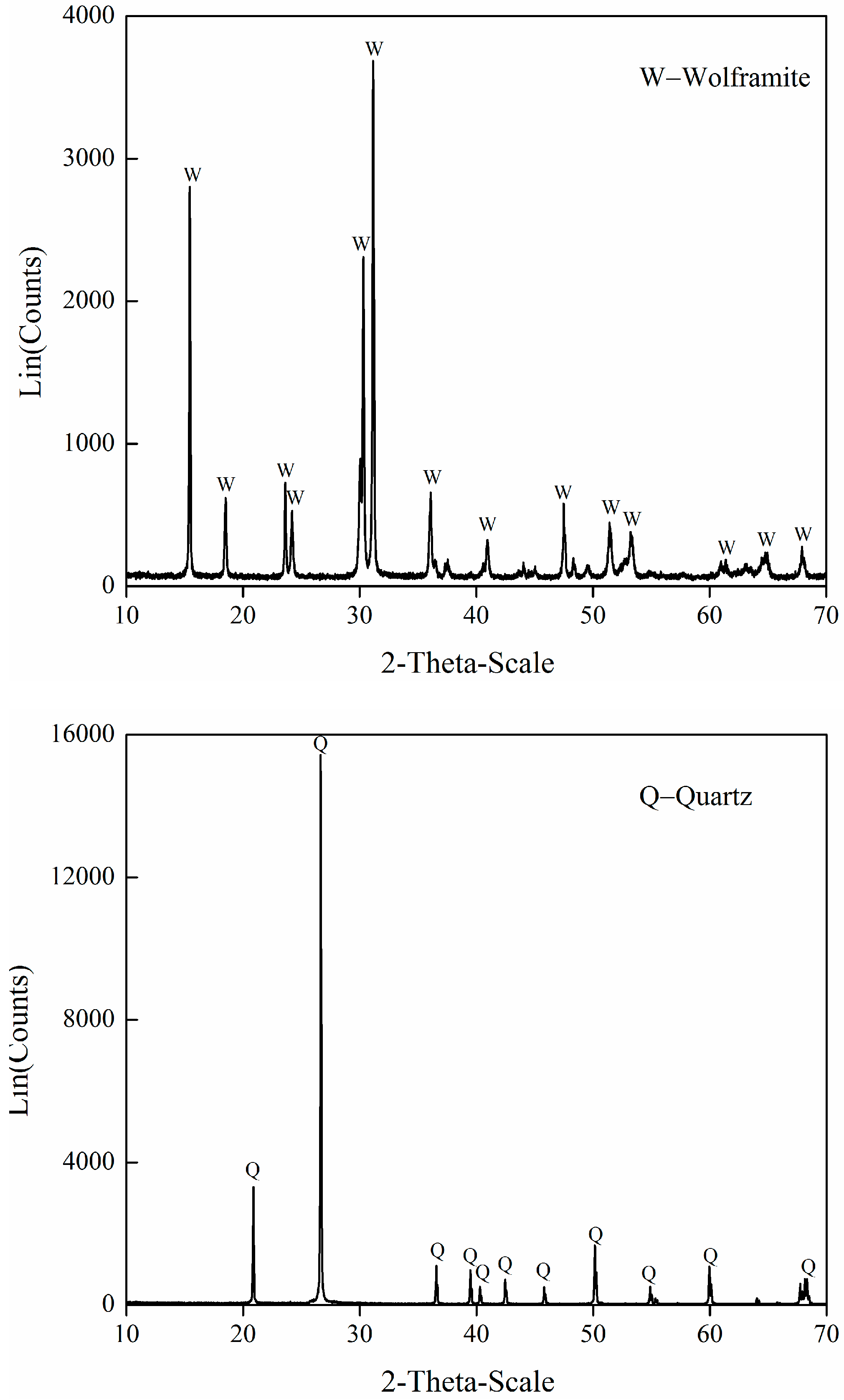

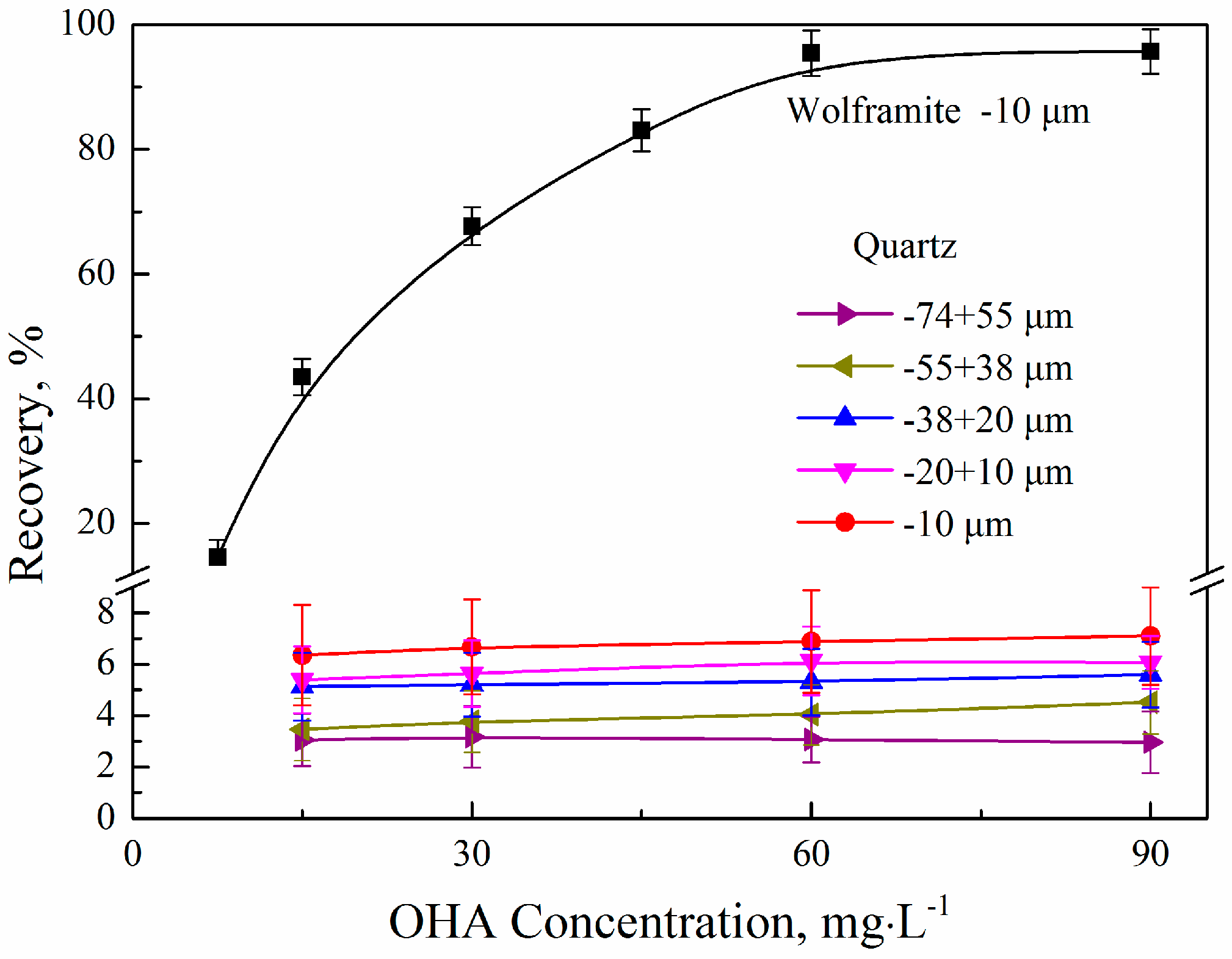
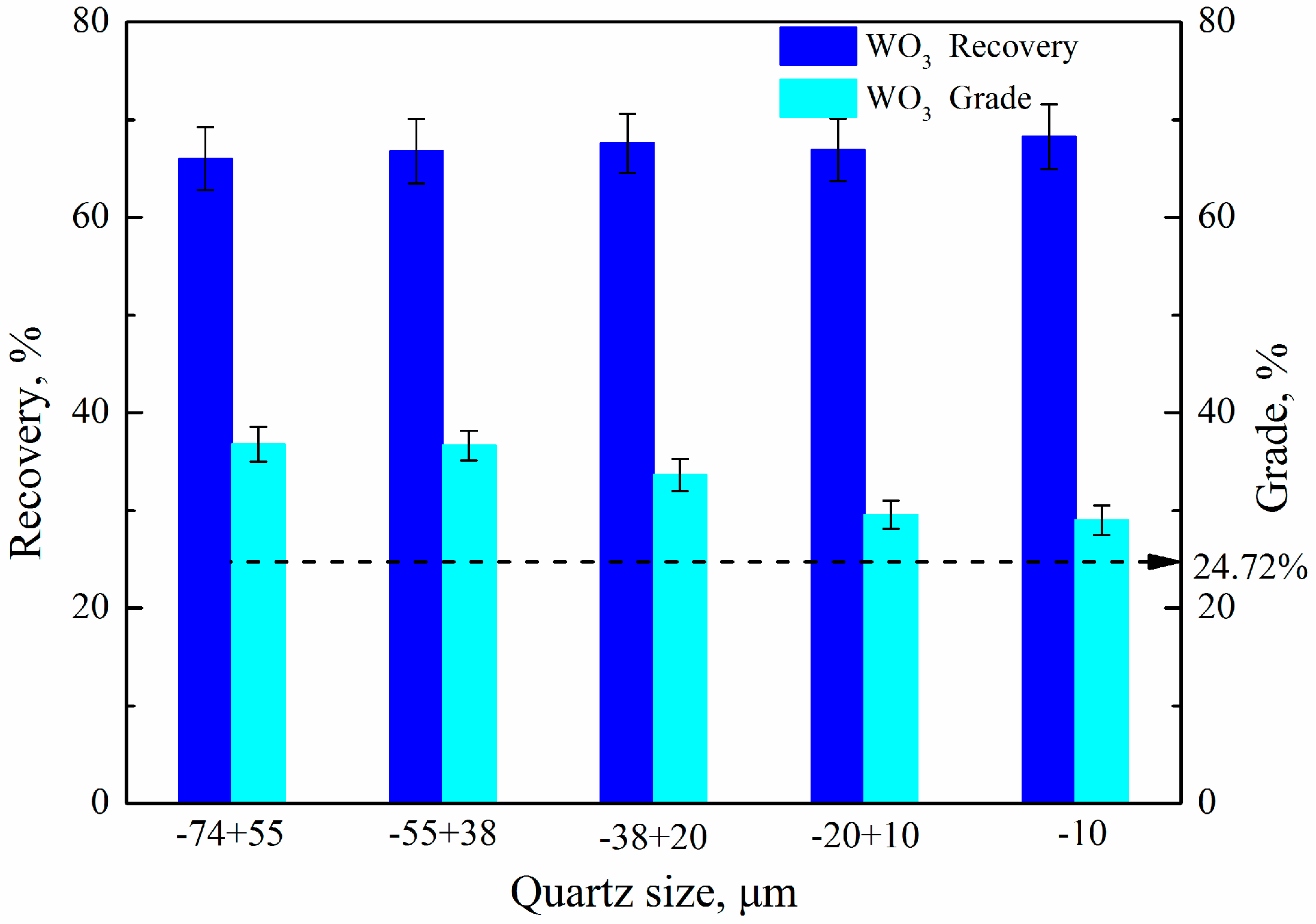

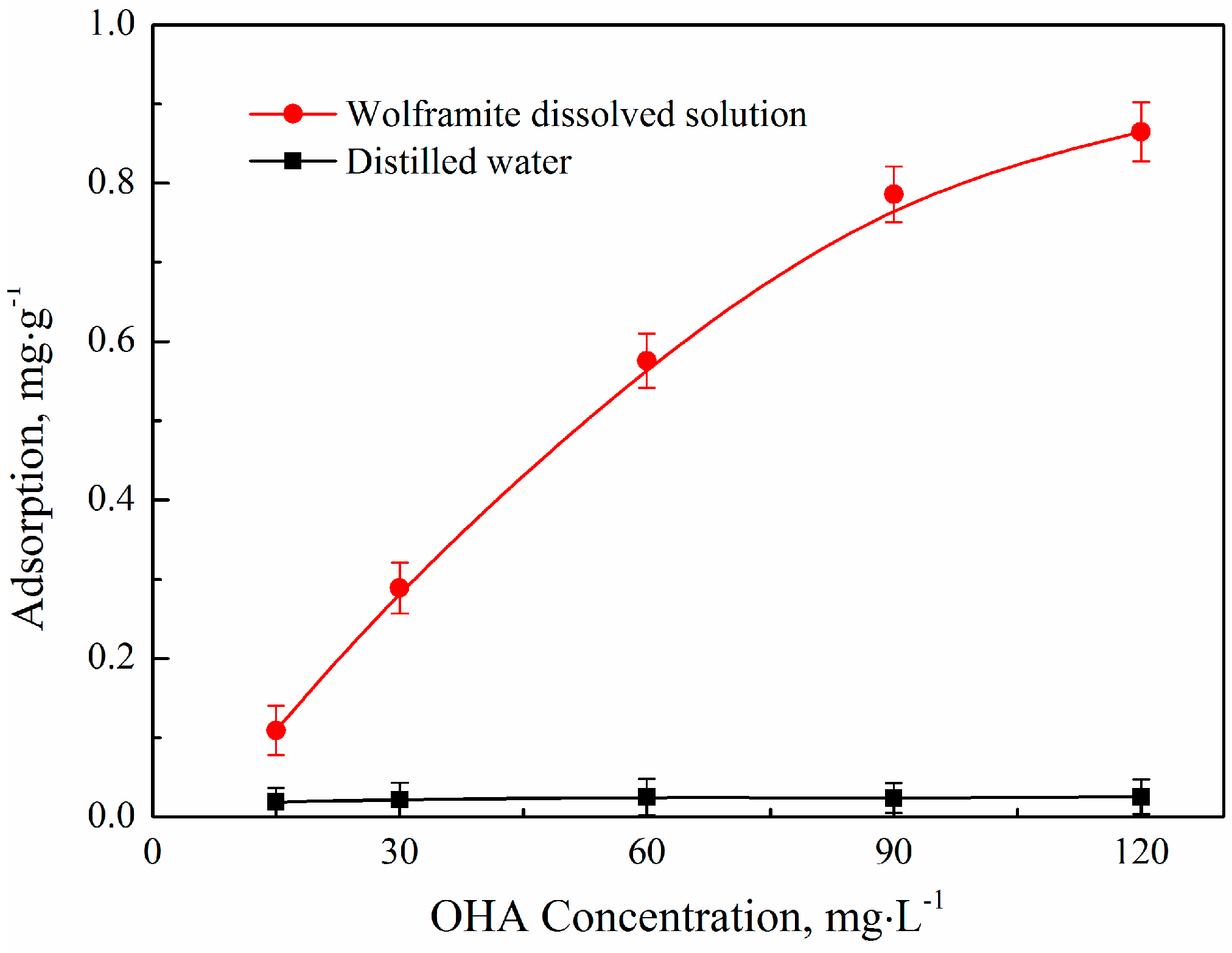
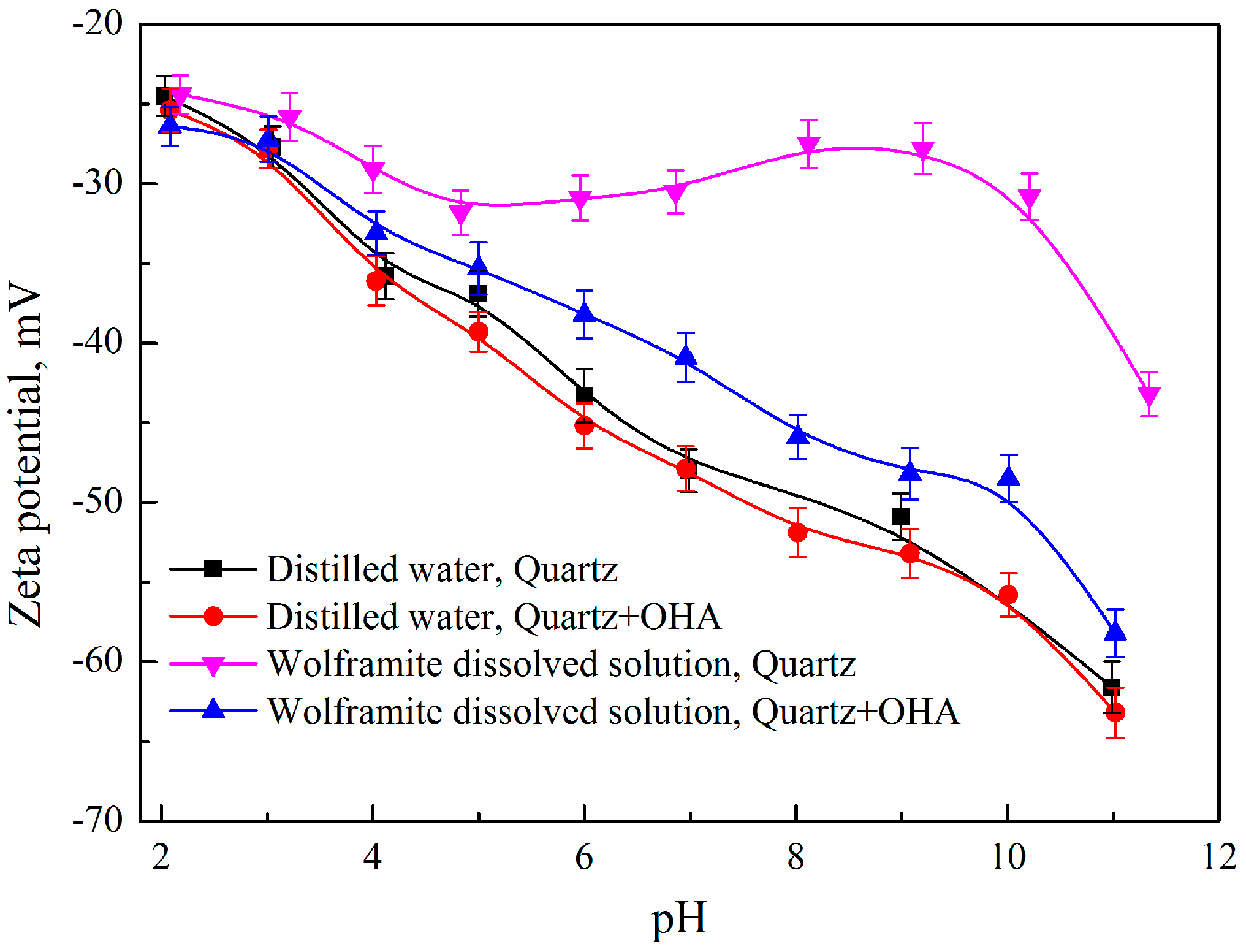
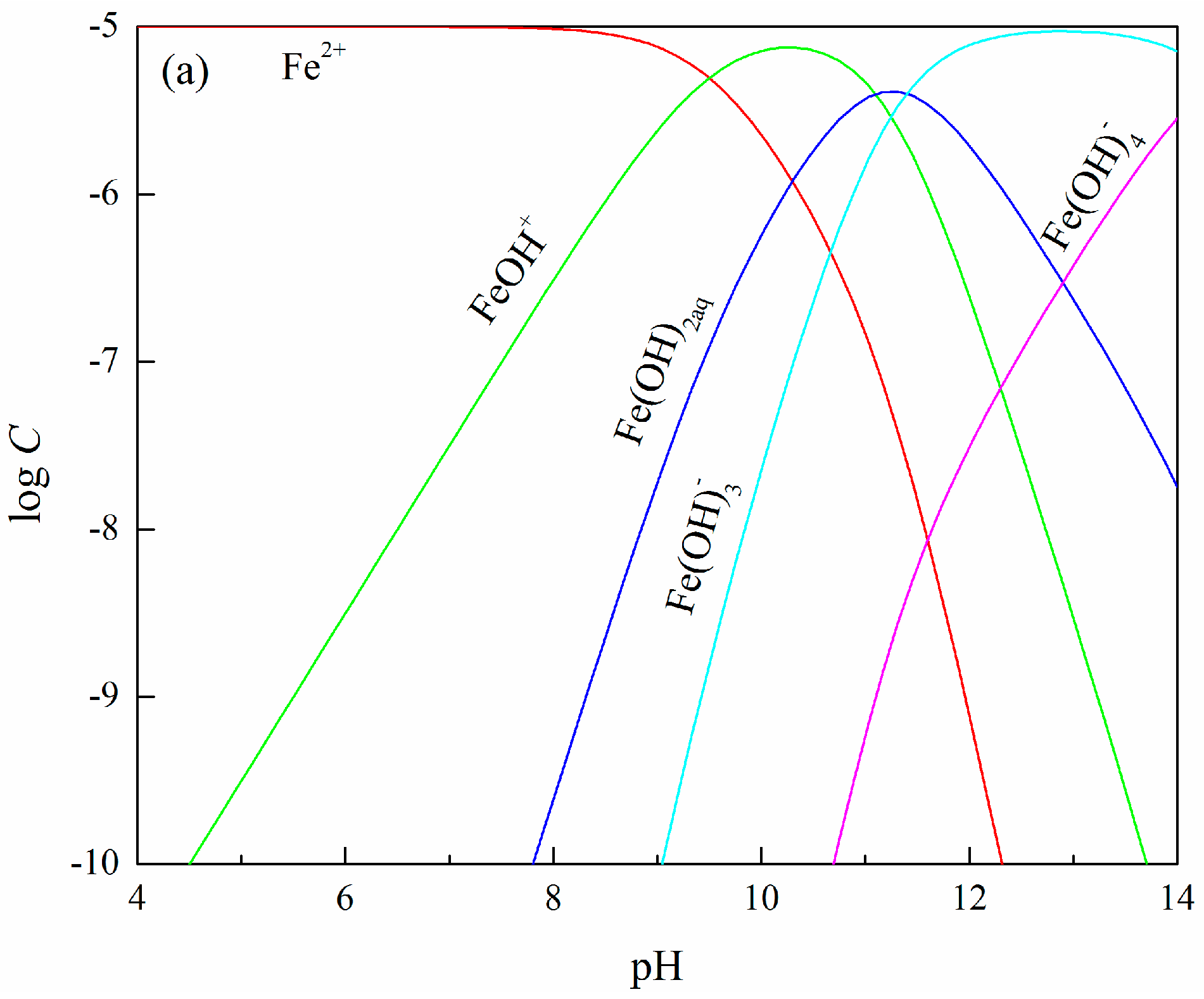
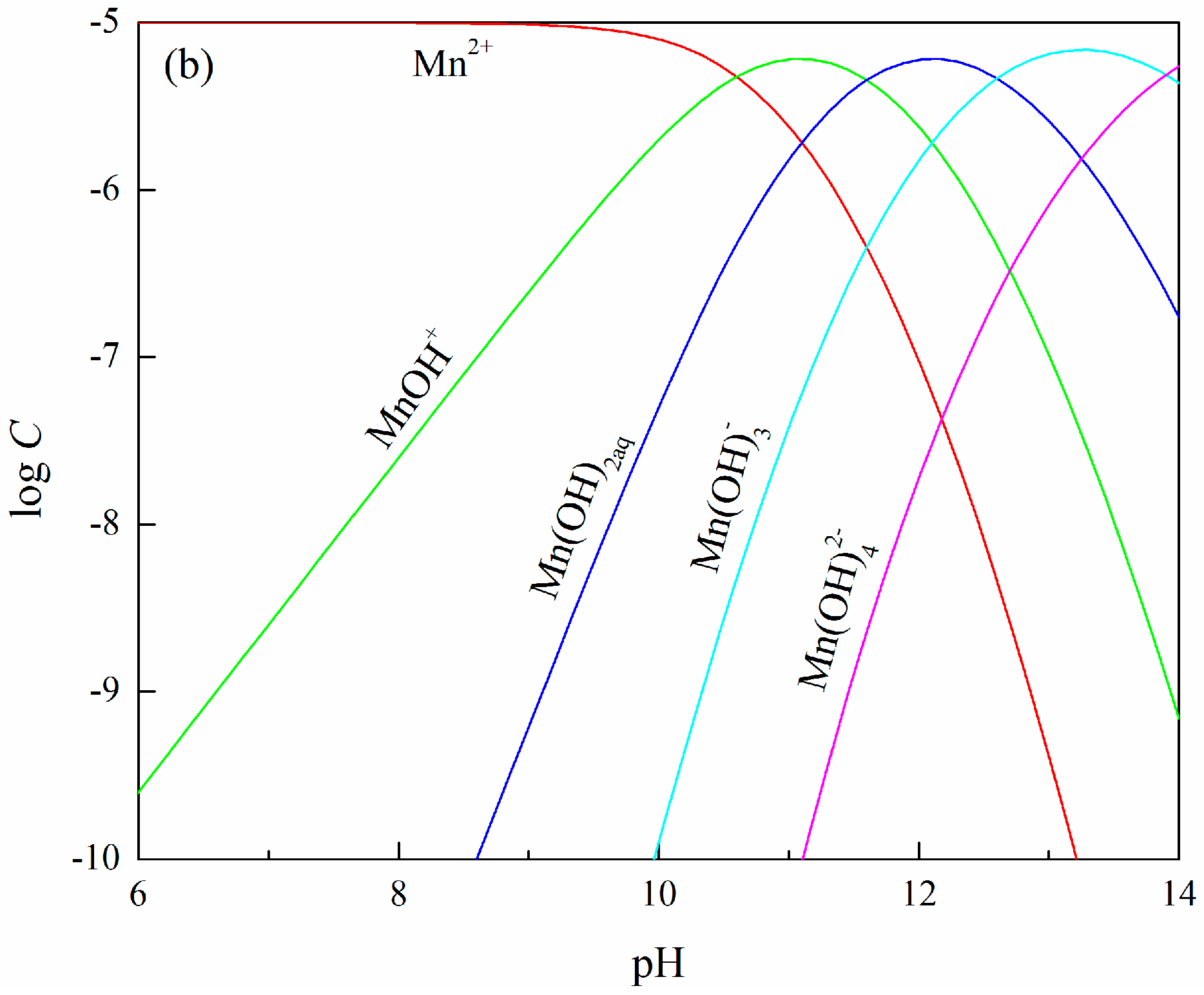
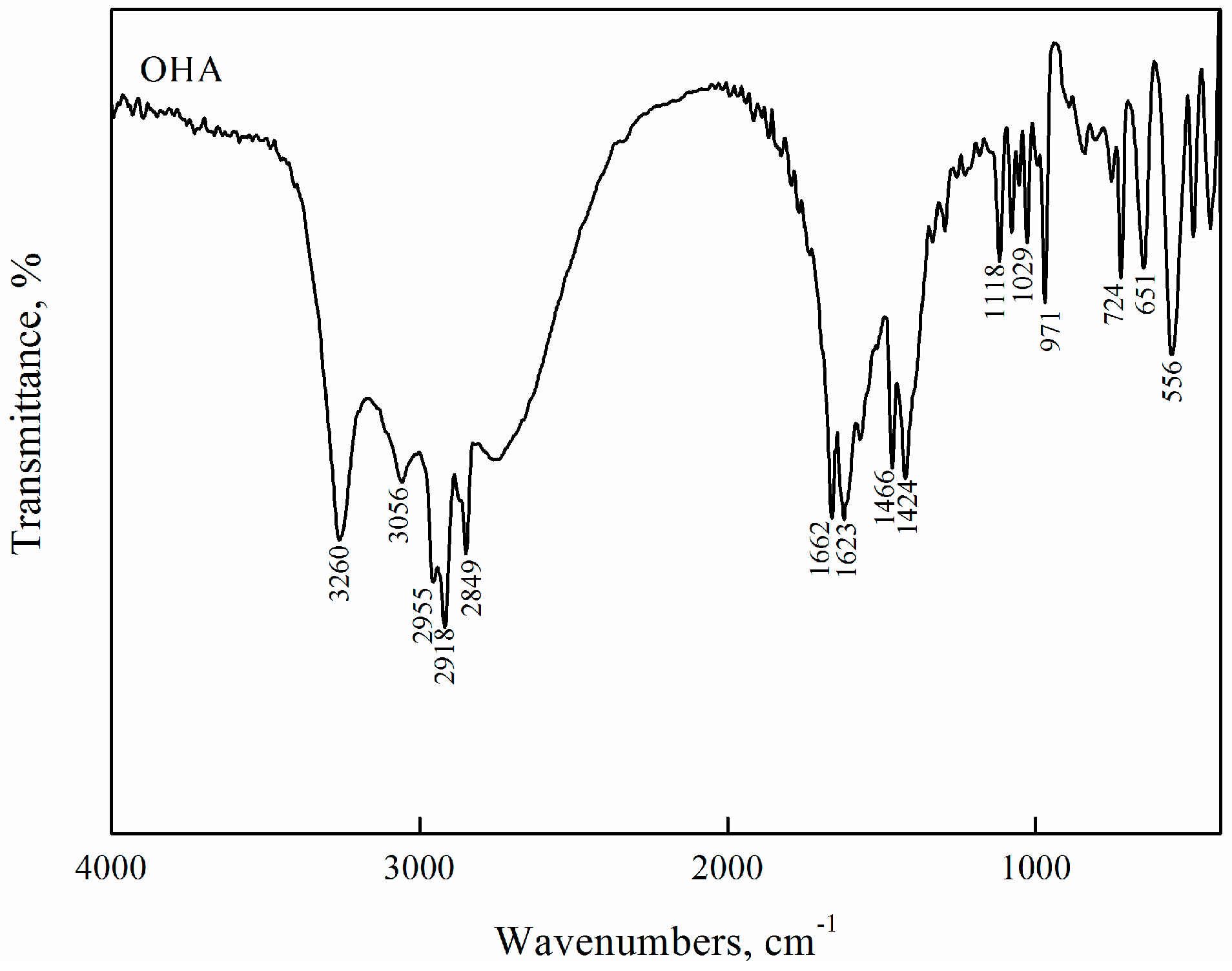
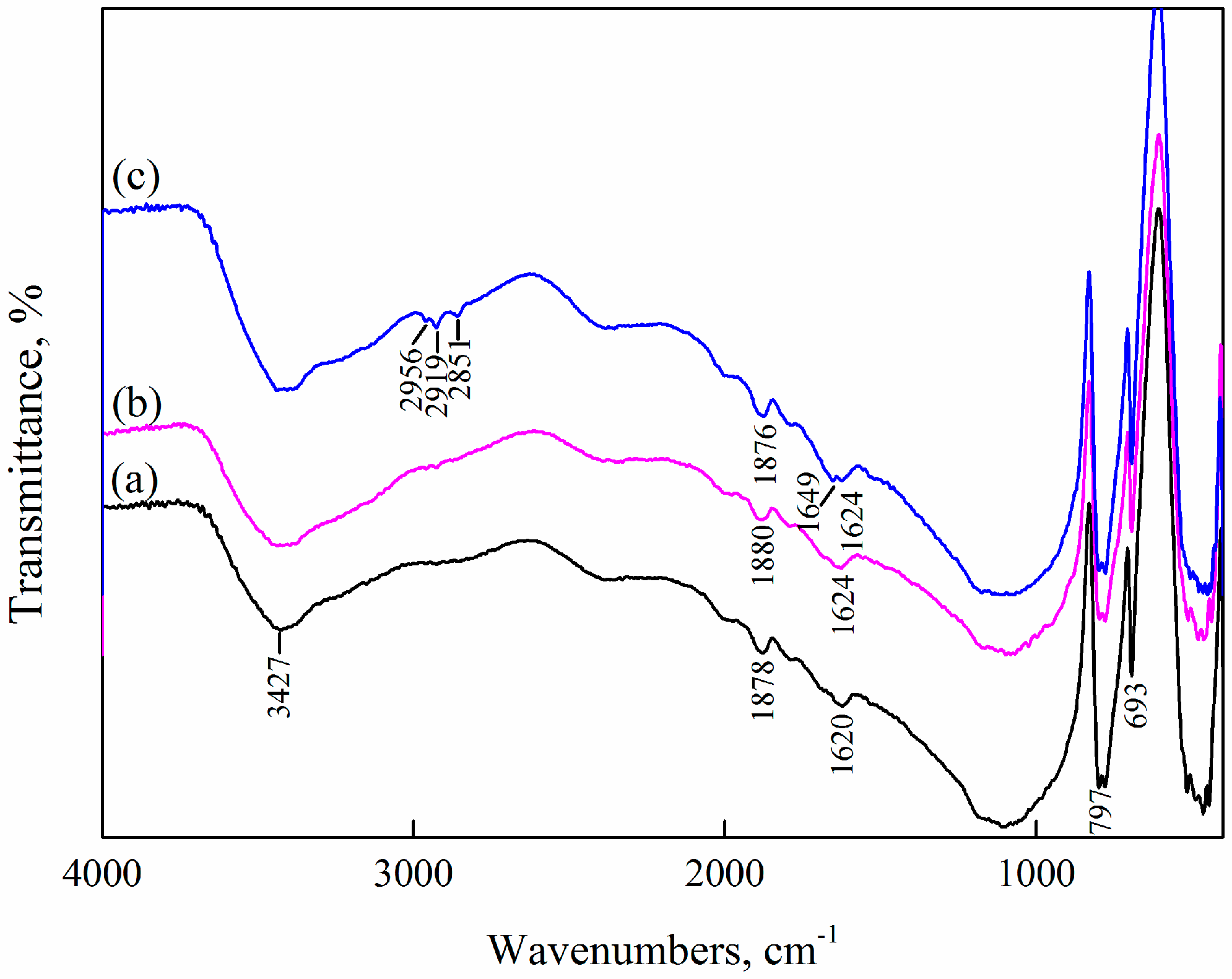

| WO3 | MnO | Fe2O3 | Al2O3 | SiO2 | SO3 | Others |
|---|---|---|---|---|---|---|
| 74.18 | 8.98 | 14.30 | 0.23 | 0.67 | 0.56 | 1.08 |
| Solution pH | Fe2+ (×10−5 mol·L−1) | Mn2+ (×10−5 mol·L−1) |
|---|---|---|
| 8.02 | 0.36 | 3.69 |
| 8.99 | 0.60 | 1.58 |
| 10.25 | 0.86 | 0.66 |
© 2017 by the authors. Licensee MDPI, Basel, Switzerland. This article is an open access article distributed under the terms and conditions of the Creative Commons Attribution (CC BY) license (http://creativecommons.org/licenses/by/4.0/).
Share and Cite
Meng, Q.; Yuan, Z.; Feng, Q.; Ou, L. The Effect of Quartz on the Flotation of Fine Wolframite with Octyl Hydroxamic Acid. Minerals 2017, 7, 186. https://doi.org/10.3390/min7100186
Meng Q, Yuan Z, Feng Q, Ou L. The Effect of Quartz on the Flotation of Fine Wolframite with Octyl Hydroxamic Acid. Minerals. 2017; 7(10):186. https://doi.org/10.3390/min7100186
Chicago/Turabian StyleMeng, Qingyou, Zhitao Yuan, Qiming Feng, and Leming Ou. 2017. "The Effect of Quartz on the Flotation of Fine Wolframite with Octyl Hydroxamic Acid" Minerals 7, no. 10: 186. https://doi.org/10.3390/min7100186




